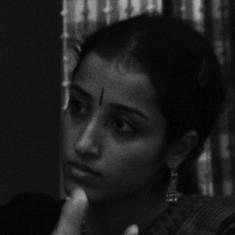This isn't a new phenomenon. Over the decades, Tamil Nadu's walls and signboards have borne witness to (and aided) the transformation of Jayalalithaa from a young movie heroine into the leader of the state. She is possibly the politician who has best exploited the historic connection of Tamil cinema and state politics. Jayalalithaa has astutely used the tools of cinematic advertising to elevate herself from film star to political celebrity.
In the 1960s, “she was first a film actress where as the heroine she was in a subservient role to the film star or hero”, said Preminda Jacob, an art historian and author of the book Celluloid Deities: The Visual Culture of Cinema and Politics in South India. That hero was very often MG Ramachandran, or MGR as he was called, who was also Jayalalithaa’s political mentor. “When she was coming to power she was shown as with her hands folded, getting MGR’s mystical aura upon her,” Jacobs said.


Photo: Preminda Jacob.
Image: Preminda Jacob.
Both MGR and Jayalalithaa openly celebrated religiosity despite the fact that atheism was at the core ideology of the Dravida Kazhagam, the political party spawned the AIADMK and its rival, the Dravida Munnetra Kazhagam. After all, Jacobs said, they could not portray themselves as gods if they disavowed religion.

When Jayalalithaa became chief minister for the first time in 1991, her image shifted from the woman who was MGR’s reverential understudy to a leader in her own right. She became Amma, a maternal figure who is the protector of the Tamil race. “She was depicted as Lakshmi or Meenakshi or even the Madonna,” Jacob said.

Photo: Preminda Jacob

Photo: Preminda Jacob

Photo: Preminda Jacob
This was a period when the biggest players in Tamil Nadu politics forced themselves into the visiion of their constituents through giant cut-outs propped up on bamboo poles. Jayalalithaa’s cut-outs invariably towered over the rest. Journalist Vaasanthi Sundaram, in her book Cut-Outs, Caste and Cine Stars, describes the day Mother Teresa saw the giant cardboard Jayalalithaa’s of Chennai.
Mother Teresa craned her neck and looked up at the sky. Jayalalithaa’s head was hidden among the clouds.
‘Good heavens,’ said a shocked Mother Teresa, ’it’s so huge!’
Her escort was amused by her reaction.
‘Have you never seen such cut-outs?’ she asked.
Still watching the passing parade of cut-outs, Mother Teresa replied, ‘No, nowhere in the world.’
‘You may find it odd,’ agreed the lady official, ‘but in Tamil Nadu, people may find it odd if there were no cut-outs! It is a common sight, whether is it for cinema advertisements or to show respect for their leader. The size of the cut-out is very important. It is regarded as a measure of loyalty to your leader.’ She laughed.
Vaasanthi goes on to describe how Mother Teresa, shocked that a few thousand rupees could be spent on each cut-out contemplated how many poor people could be fed at that cost. However, when she met Jayalalithaa later, the chief minister charmed her and even won praise for her social awareness from the ascetic nun.

Image: Preminda Jacob
The mega image projection backfired in 1996 when Jayalalithaa was first accused in of having acquired assets disproportionate to her declared sources of income. Karunanidhi and the DMK took over the government and in a savvy move pulled back on the huge cut-outs, which until then had been very advantageous to politicians. “The DMK was trying to send the message that ‘we are not following in her track in all this mega corruption’,” said Jacob.
Today, as Jayalalithaa attempts to obtain bail as she is lodged in a Bangalore jail, her sympathisers are printing up images of comparing her to a lion or a phoenix. It’s still the most effective form of communication and show of devotion. “Over the space of half century the population has been very adept on how to read these images," said Jacob. "You don’t need long explanations. One can look at the image and just by the red and black colours, the few symbols.”
Along with the ability to read a political message, the people of Tamil Nadu have also come to expect the latest news of their Amma through this show-and-tell.











